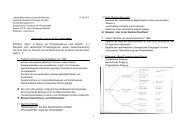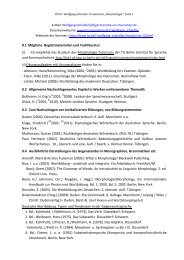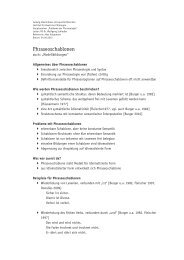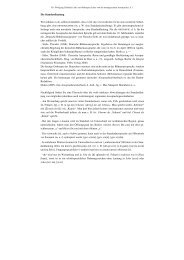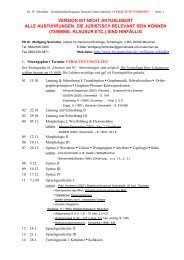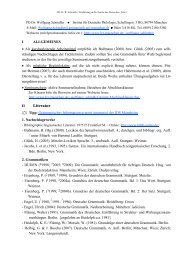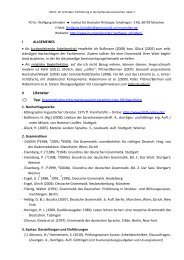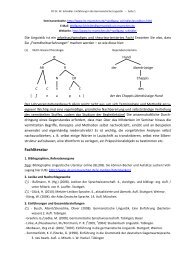Chapter 18 Lexical Functions: Description of Lexical Relations in a ...
Chapter 18 Lexical Functions: Description of Lexical Relations in a ...
Chapter 18 Lexical Functions: Description of Lexical Relations in a ...
You also want an ePaper? Increase the reach of your titles
YUMPU automatically turns print PDFs into web optimized ePapers that Google loves.
—<strong>Chapter</strong> <strong>18</strong>. <strong>Lexical</strong> <strong>Functions</strong>— 17<br />
• at least some <strong>of</strong> its elements cannot be specified without a direct reference to L as an <strong>in</strong>divi-<br />
dual LU.<br />
A degenerate LF specifies for L a lexical expression L´ that appears, generally speak<strong>in</strong>g,<br />
with no other LU, because L´’s mean<strong>in</strong>g <strong>in</strong>cludes the mean<strong>in</strong>g <strong>of</strong> L ((L´) ⊃ (L)).<br />
Comments on Def<strong>in</strong>ition <strong>18</strong>.3<br />
1. The value <strong>of</strong> an LF f for the LU L—f(L)—is, generally speak<strong>in</strong>g, a SET <strong>of</strong> l<strong>in</strong>guistic expres-<br />
sions {L´i}. An element <strong>of</strong> f(L) can be, as we have seen, an LU (a lexeme or a phraseme), a<br />
morphological sign (a compound<strong>in</strong>g stem or an affix), or else a free phrase. The elements <strong>of</strong> the<br />
value f(L) need not be strictly synonymous: they must be only more or less synonymous—shar-<br />
<strong>in</strong>g an important semantic component (f), which is associated with f (for more details, see 5.1.1, p.<br />
00).<br />
2. Condition A1 guarantees the homogeneity <strong>of</strong> f(L): for any two keywords, the semantic<br />
and/or syntactic relationships between any element <strong>of</strong> f’s value and the keyword rema<strong>in</strong>s approxi-<br />
mately the same. The researcher is free to determ<strong>in</strong>e himself how approximate this may be—<br />
accord<strong>in</strong>g to the task he sets himself. The identity <strong>of</strong> the semantic relationship between L and an<br />
element <strong>of</strong> the value f(L) is relative: it depends on the degree <strong>of</strong> granularity chosen by the resear-<br />
cher as well as on the level <strong>of</strong> analysis. Consider two collocations: The PREDICTION comes true [=<br />
‘beg<strong>in</strong>s to be reality’] and The FILM opens [= ‘beg<strong>in</strong>s to be screened’]; both underscored express-<br />
ions are elements <strong>of</strong> the value <strong>of</strong> the LF IncepFact 0 for the respective keywords (<strong>in</strong> small caps).<br />
Of course the semantic relationships between, on the one hand, come true and prediction and, on<br />
the other hand, open and film are not literally the same. They can, however, be considered the<br />
same on a more abstract level: <strong>in</strong> both cases, the entity denoted by the keyword ‘does what it is<br />
expected to do’: thus, a prediction is expected to become reality, and a film, to be screened. The<br />
lexicographic def<strong>in</strong>itions <strong>of</strong> the LUs PREDICTION and FILM must <strong>in</strong>clude the correspond<strong>in</strong>g<br />
components.<br />
3. Condition A2 establishes the saturated character <strong>of</strong> f(L): f is maximal <strong>in</strong> that it returns ALL<br />
possible elements <strong>of</strong> any given value for any LU. Thus, any <strong>in</strong>tensifier <strong>of</strong> L must belong to the<br />
value f(L) <strong>of</strong> f that covers the <strong>in</strong>tensifiers—this f is the LF Magn (see below). An L´ that does not<br />
belong to Magn(L) cannot be an <strong>in</strong>tensifier <strong>of</strong> L.<br />
4. Condition A3 ensures the phraseological character <strong>of</strong> f(L). Conditions A1 and A2 characte-<br />
rize f as a potential LF: they require only the existence <strong>of</strong> the proportion L´1 : L1 = L´2 : L2<br />
and the <strong>in</strong>clusion <strong>of</strong> all appropriate elements <strong>in</strong> the value. Condition A3, on the other hand,



![E-Mail: Wolfgang.Schindler[ätt]germanistik.uni-muenchen.de Web ...](https://img.yumpu.com/51590147/1/184x260/e-mail-wolfgangschindlerattgermanistikuni-muenchende-web-.jpg?quality=85)
